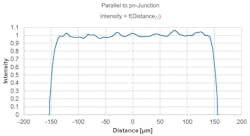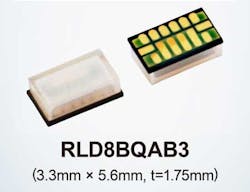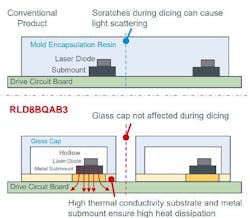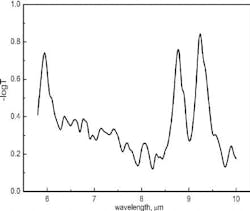1-kW Laser is Brilliant for Automotive LiDAR
What you’ll learn:
- ROHM’s RLD8BQAB3 1-kW, 905-nm, 8-diode laser array comes in a 5.6- × 3.3-mm SMD package.
- The spectral output is well-suited to ADAS applications for high-speed vehicles, providing scene illumination at great distances in non-ideal conditions like fog.
- About our EDitor’s Take on this new component’s design considerations.
ROHM Semiconductor recently announced a new high-output laser diode, the RLD8BQAB3, for use in advanced driver-assistance systems (ADAS)-equipped with LiDAR for distance measurement and spatial recognition. Beyond ADAS, the 8x 125-W, 905-nm laser array targets consumer and industrial applications.
LiDAR has seen growing adoption in recent years across a variety of applications that require automation (e.g., automotive ADAS, SDVs, AGVs, drones), facilitating precise distance measurement and spatial recognition. To detect information at greater distances with more accuracy, the need arises for laser diodes that serve as light sources that deliver high, kW-level, illumination while enabling multiple light sources to emit light at close spatial intervals.
ROHM has established proprietary, patented technology that achieves narrow emission width (Fig. 1), enhancing performance of long-distance, high-accuracy LiDAR. Its new 1-kW-class array-type product meets the demand for a high-output, high-performance laser diode.
ROHM Laser Diode Leverages 3D ToF
The RLD8BQAB3, an ultra-compact, surface-mount, high-output 125-W × 8-ch infrared laser diode for LiDAR applications, utilizes 3D time-of-flight (ToF) systems to conduct distance measurement and spatial recognition. The optimized design features eight emission areas (each 300 µm wide) per element, installed on a sub-mount affixed to a high-heat-dissipation substrate (Fig. 2).
The package’s emitting surface incorporates a clear glass cap (Fig. 3)—an industry first for a surface-mount laser diode—eliminating the risk of light scattering caused by scratches during dicing that tends to occur with resin-encapsulated products, ensuring high beam quality. Each emission area is wired with a common cathode. This enables selection of the irradiation method based on application needs, ranging from individual emission that increases the number of light-emitting points to industry-leading simultaneous emission at ultra-high 1-kW class output.
This new product retains the key features of ROHM’s conventional laser diodes, including uniform emission intensity across the emission width along with a low-wavelength temperature dependence of 0.1 nm/°C (vs. 0.26 to 0.28 nm/°C for standard products). In addition, the array configuration narrows the regions of reduced emission intensity between channels. Meanwhile, the bandpass filter minimizes the effects of ambient light noise from the sun and other sources, contributing to long-distance detection and high-definition LiDAR.
>>Check out this TechXchange for more articles on LiDAR technology
Samples are available now. The datasheet is attached here for our readers’ convenience, though it’s wise to pick up the latest release from ROHM when doing an actual design.
EDitor’s Take
I got pretty excited at the eyeball-searing levels of power that this 1-kW semiconductor laser array could put out, because I always find myself thinking about out-of-the-box applications for such things. Can it be attached to a copper or silver, water-cooled or alcohol-heat-piped, block and be run CW? What would the optical design look like in order to build a cheap kW-class laser cutter or welder, if it can be cooled? Maybe use one of the diodes as a die-temperature sensor (a small temp-sensing diode in future versions would be nice)?
Pulsed power operation in LiDAR applications is the way to keep this crazy 1-kW power output from frying retinas under the IEC's 60825-1 common safety framework. I've asked for ROHM to write a contributed article on eye safety to supplement this high-power laser array announcement. It will appear on Electronic Design in the very near future.
On the electrical side, each diode needs about 41 A of forward current and drops 15 V typ. to produce typical power of 125 W per diode in operation, according to the datasheet. One aspect I find weird as a high-speed designer is the use of common-cathode for the 8-diode laser array. I would have preferred to see a common anode architecture that allows for the use of NMOS/NPN CML to drive the diodes. It would fast switch them down to through a current source or long-tail resistor (pretty much a piece of wire at these currents!) to ground in beamsteering, or quantized-illumination, ToF applications. Freespace, 8-level PAM comms link, anyone?
For designers who pulse the entire array simultaneously, common-cathode won’t be a problem, of course, since only one NMOS/NPN switch is pulsing...328 A. I suppose a giant 400-A knife-switch will do for those who are bold enough to Frankenstein this thing to work in CW without letting the magic smoke out.
For readers wondering about the wavelength, I’ve looked up the absorption spectrum of fog for you and (Fig. 4) peak transmission (low absorption) happens to be at...905 nm. For highway speeds, LiDAR needs to throw a lot of power out there to illuminate objects 3 or 4 seconds away (stopping distance, processing time), with atmospheric attenuation in conditions like fog being the major distance-limiting factor. I suppose we should be thorough and look into smog’s absorption spectrum, too, given a new desire to embrace “beautiful, clean coal.”
This ROHM laser array is a definite design-in challenge from a power supply, switch, and optical design perspective to support this part. However, it does enable some interesting system design possibilities with its precise array spacing and combined illumination power.
This part is what I like to call a “technology trigger.” It enables some new capabilities and applications in ADAS, ranging, and other applications. Feel free to comment below about possible applications or to share your designers’ insight.
Ed note: After writing this, I realized that, in my haste to get this piece out, I used a far-IR absorption chart and confirmation-biased myself into 9 µm being 905 nm (0.9 µm), which it's obviously not. For a discussion of near-IR absorption in LiDAR, this paper is the appropriate one. Please ignore my excited and erroneous diversion in this article.
Andy's Nonlinearities blog arrives the first and third Monday of every month. To make sure you don't miss the latest edition, new articles, or breaking news coverage, please subscribe to our Electronic Design Today newsletter. Please also subscribe to Andy’s Automotive Electronics bi-weekly newsletter.
About the Author
Andy Turudic
Technology Editor, Electronic Design
Andy Turudic is a Technology Editor for Electronic Design Magazine, primarily covering Analog and Mixed-Signal circuits and devices. He holds a Bachelor's in EE from the University of Windsor (Ontario Canada) and has been involved in electronics, semiconductors, and gearhead stuff, for a bit over a half century.
"AndyT" brings his multidisciplinary engineering experience from companies that include National Semiconductor (now Texas Instruments), Altera (Intel), Agere, Zarlink, TriQuint,(now Qorvo), SW Bell (managing a research team at Bellcore, Bell Labs and Rockwell Science Center), Bell-Northern Research, and Northern Telecom and brings publisher employment experience as a paperboy for The Oshawa Times.
After hours, when he's not working on the latest invention to add to his portfolio of 16 issued US patents, he's lending advice and experience to the electric vehicle conversion community from his mountain lair in the Pacific Northwet[sic].
AndyT's engineering blog, "Nonlinearities," publishes the 1st and 3rd monday of each month. Andy's OpEd may appear at other times, with fair warning given by the Vu meter pic.






